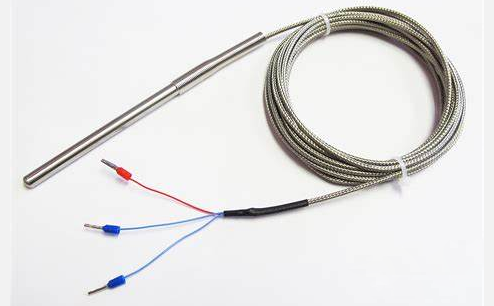

Resistance temperature coefficient (α)
The resistance temperature detector (RTD) is a special temperature sensing element made of fine metal wires. The resistance changes with temperature, which is similar to the following formula:
in,
RT = RTD temperature sensor resistance (ohm) under the given temperature T
RREF = Refer to the RTD temperature sensor resistance TREF (Om) at the temperature
α = resistance temperature coefficient (ohm/ohm/degree)
The following example shows how to use this formula to calculate the temperature coefficient value of 0.00392 "100 ohm" platinum RTD temperature sensor at a temperature of 35 degrees Celsius:
RT = 100 [1 + (0.00392)(35 o C − 0 o C)]
RT = 100 [1 + 0.1372]
RT = 100 [1.1372]
RT = 113.72
Due to the non -linear of RTD behavior, this linear RTD temperature sensor formula is just a similar value. The better approximation value is the Calleendar-Van dusen formula. It introduces the second, third and fourth-order items to obtain better fitting:
RT = RREF (1 + AT + BT 2 − 100ct 3 + CT 4) The temperature range is −200 O C <0 O C and
RT = RREF (1 +AT +BT 2), the temperature range is 0 o c <6661 O C,
It is assumed that TREF = 0 O C. A, B and C coefficients change with specific types of RTD, which is equivalent to α in a linear RTD temperature sensor.
The melting point/freezing point of water is the standard reference temperature of most RTD temperature sensors. The following are typical α values of some common metals:
Nickel = 0.00672 ω / ω o C
Tungsten = 0.0045 ω / ω o C
Silver = 0.0041 ω / ω o C
Gold = 0.0040 ω / ω o C
Platinum = 0.00392 ω / ω o C
Copper = 0.0038 ω / ω or C
As mentioned earlier, platinum is a common wire of the industrial RTD temperature sensor structure. Platinum's Alpha (α) value changes according to the degree of alloy of metal. For the "reference" platinum wire, the most common Alpha value is 0.003902. Industrial -grade platinum alloy RTD lines usually have two different coefficient values: 0.00385 ("Europe" Alpha value) and 0.00392 ("American" Alpha value), of which the most commonly used "Europe" is 0.00385 (even in the United States!).
Another method of predicting the RTD temperature sensor resistance with a mathematical method is to simply find the relationship between the prediction resistance and the temperature in the value table published by the RTD type. The table can capture the non -linear difference between RTD non -linearly without increasing any mathematical complexity: just find the resistance corresponding to the given temperature, and vice versa. If one value falls between the two recent entries in the table, you can insert the required value you need, treat the two nearest table entries as the endpoint of the line segment, and calculate the point you want along the line.
100 ω is a very common reference resistance for industrial RTD temperature sensors (RREF at 0 degrees Celsius). 1000 ω is another common reference resistance. The reference resistance of some industrial RTDs is as low as 10 ω. Compared with the resistance of tens of thousands or even hundreds of thousands of ohms, the RTD resistance is relatively small. This may lead to a problem with measurement, because connecting the RTD to its Ohm watch has its own resistance. Compared with thermal resistance, the resistance occupies a larger percentage in the total circuit resistance.

